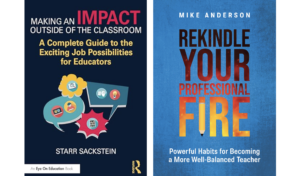Can You Really Own Something You Didn’t Choose?
“How’d it go?” On the surface, it is such a basic question. I’ve been asked that question plenty of times in my life. After a sports game, doctor’s appointment, or school meeting, not to mention that nerve-wracking best man’s speech for my brother. I never thought it was a tough question to answer. But if you’ve ever asked your students this after a test, then you probably already know that 99% of the responses are “I don’t know,” “I have no clue,” or a simple shoulder shrug. At least this is what I seemed to get every time I asked my middle school students after a test.
I knew they felt comfortable enough with me to answer; they were certainly a lively bunch on most days. Why couldn’t they answer? I soon fell into a hard truth. I could always answer the question because it was my game, my appointment, my meeting, my speech. But my students didn’t feel that same type of ownership. It wasn’t their test, it was mine. The questions, the set-up, the delivery, the scoring. They were doing everything on my terms, not theirs.
This dynamic had to change if I was ever going to get the answer to my question. Once I made this connection, I didn’t just want to know the answer to this “throwaway” question, I needed to. If I was going to get more thoughtful answers, I had to change the environment surrounding my test. It needed to be theirs. I wasn’t sure what this would look like, but I was pretty sure what it shouldn’t look like.
At this point in my career, I was very comfortable with what I was comfortable with. But I always liked trying new things. If it worked, great. If it didn’t, learn and move on. At the time, we were almost a year into our school PD centered on student motivation. I was naturally drawn to the focus on autonomy.
Getting students to have ownership in their learning was certainly not a foreign concept to me. But authentically manufacturing it was always eluding me. After metaphorically (okay, sometimes literally) banging my head against the wall, I knew I had to change my approach. Working backwards, a simple thought progression would help me get started:
For students to own their learning, it had to be theirs.
For it to be theirs, they had to choose to do it.
For them to choose to do it, they needed choices.
They needed the ability to choose what they were going to do if they were going to own it. That’s it. And then we were off and running. I just had to provide the choices for how they were going to show both of us what they knew.
So when the next math assessment rolled around, I offered my students several choices, all of which assessed the same four standards. They could take a traditional quiz, work through a partially filled table, complete a Kahoot quiz, or try their hand at self-selecting problems from a brand-new Heat-Map worksheet based on varying difficulties. This last option gave them the ability to pick what questions to solve next depending on whether they felt confident (hot/red) or not (cold/blue) after each problem.
Students were encouraged to complete at least two of the options. After each, they reflected in a shared document to explain why they chose the options they did and how they thought the options went. These reflections were the best answers to the “How’d it go?” questions I’ve ever seen.
Some students chose the prototypical quiz because “it was the one I was most comfortable with.” Others picked the partially filled in table because “I am more of a visual learner so I like to write it out more” and it was an “easier way to just break down the problem.” Some liked the Kahoot because “It gave me more answer choices, and instant feedback.” Finally, there was the Heat Map Worksheet. A lot gravitated here as they wanted to “try something new,” “work at my own pace,” and (my personal favorite) “I wanted to challenge myself.”
Over the next few days, I would look at surveys, talk to the class, meet with the teachers I had in to observe the lesson, and look at their finished products (a term I used because “test” didn’t seem to fit– no two students handed in the same problems). I’m always looking for feedback and was looking forward to learning more about how this whole experience was for them.
I thought the pace was hectic; they thought they were super productive.
I worried they were stressed; they said they never felt less anxiety taking a math test.
I wasn’t sure they would make good choices; their self-reflection was some of the best I’ve ever seen.
Ironically, before I had gathered all of the students’ feedback, a colleague asked me, “How’d it go?” At the time, all I could give her was a shoulder-shrug and a quick “I don’t know”. Probably because it wasn’t my test.
Author
-

Tom Tuscano has been a math teacher at Dodd Middle School in Cheshire, Connecticut for the past eleven years. He has also served as the Division Leader and a math coach. He has co-written curriculum for both seventh and eighth grades and led professional development on topics such as standards-based assessments, personalized learning, and using choice as a motivator for students. His favorite part about being a teacher is when “that lightbulb” goes off and students know they can be successful. Outside of the classroom, Tom enjoys spending time with his wife and three sons as well as coaching high school football.
You may also like

Feeling Burned Out? Maybe It’s Time for a Shake-Up!
- July 12, 2024
- by Mike Anderson
- in Blog

How Teachers Can Forge Instructional Autonomy

Classroom Management 101: A Refresher
Leave a ReplyCancel reply
This site uses Akismet to reduce spam. Learn how your comment data is processed.


Comments
I am not in Education. I don’t have children. Yet I find the concepts and lessons detailed in your writing a revelation, and very applicable to the world of business and my life in general. 🙏